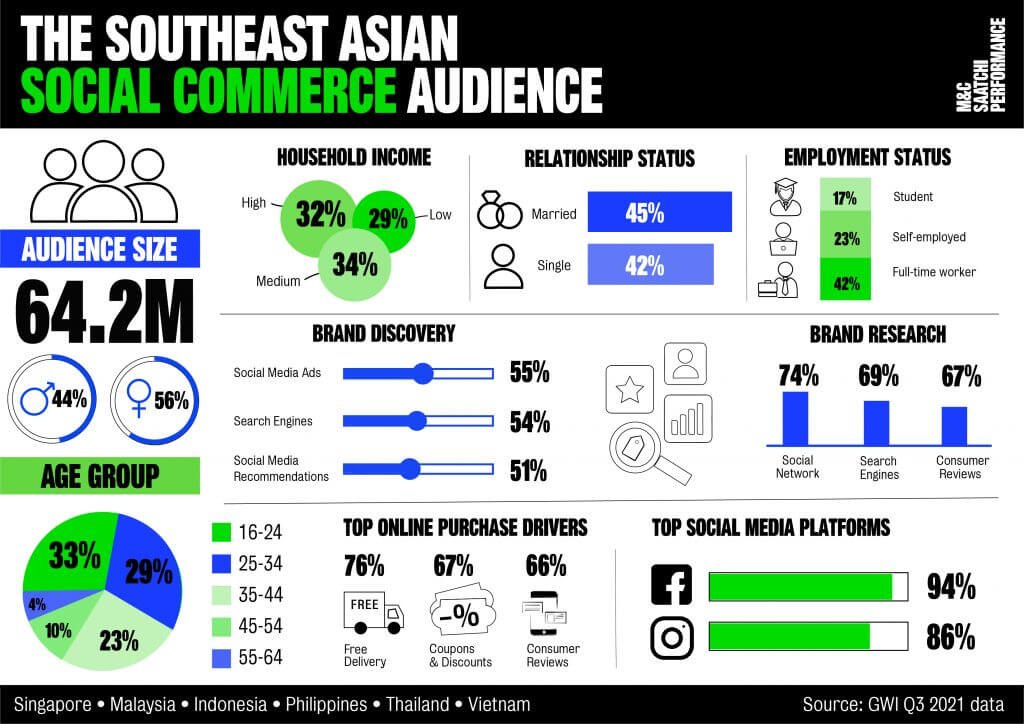
It has only been a couple of months since the start of 2022 but one thing is already clear, ‘social commerce’ is the buzzword of the year.
For those not familiar with the term, social commerce allows brands to engage with their audiences during the entire shopping journey, from product discovery until check-out process, on their favorite social media platforms.
It keeps people where they want to be by enabling social media users to do some shopping while they are interacting with friends, getting their news and watching videos all in one place. This in itself represents a valuable opportunity for social media marketing agencies.
In Southeast Asia, while e-commerce marketplaces remain the preferred online shopping channel among consumers, social commerce has contributed to 21% of online purchases In 2021. In the last year alone, it noted a 102% rise in orders, 91% rise in Gross Merchandise Value and 88% rise in average revenue per order.
What caused the boom of social commerce?
The fast growth of social commerce is due to 3 main factors, the first being the rising adoption of social media in Southeast Asia. Prolonged restrictions imposed to curb the spread of Covid-19 in the region have led to consumers spending more hours at home and turning to social media to stay connected, informed and entertained.
Another main factor has been the increasing demand for one-stop-shop platforms. Consumers are on the lookout for platforms that offer discovery and purchase. The seamless transition from discovery to purchase is becoming increasingly important among consumers.
Finally, online shoppers are looking for platforms that enable communication with sellers. Social commerce offers direct communication with brands which builds trust and enables sellers to offer better customer service and customers to receive it.
Who are social shoppers in Southeast Asia?
According to data from GWI, social shoppers in Southeast Asia constitute approximately 64.2 million people in the region. They are a young and female skewed audience, with over 55% of them being female and over 60% of them being under the age of 34. Additionally, over 40% of them are married and are employed full-time.
While social shoppers in the region are keen and willing to trying new things, they tend to extensively research products online prior to purchase, relying heavily on social media, search engines and consumer reviews for brand discovery and research. Free delivery (76%) and discounts (67%) are their primary online purchase drivers and messaging that is focused on the same is most likely to grab their attention
For brands seeking to reach this audience, social media channels especially Facebook (94%) and Instagram (86%) are channels frequented by them. They are also highly interested in entertainment, with channels such as YouTube, Netflix, Spotify, YouTube offering high reach.
Purchase drivers vary between categories
A report by Facebook and Bain & Company reveals that although social commerce spend across categories is evenly split, the purchase drivers vary between categories.
For categories such as clothing, beauty & household furnishings the key purchase drivers for customers proved to be fun shopping experiences, community connection, customization and variety of products. However, for the electronics category the drivers proved to be product price, non-branded goods and new products showcased by influencers. Similarly for groceries shoppers were encouraged by convenience, niche products, trust with neighbours and local stores.
Being a fairly new addition to the list of online shopping channels available to consumers, there are several pain points marketers should consider, such as expensive shipping costs, lack of unclear return/exchange policies, poor customer service and risk of scams that act as hindrances to growth.

The future of e-commerce lies in social commerce. Our latest M+C Saatchi Performance report, ‘The rise of social commerce in Southeast Asia’, delved into the behaviour of social shoppers in countries within the region and offered insights into what brands can do to ride the social commerce wave.


